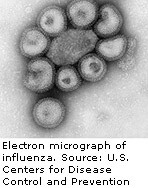Strain of H3N2 virus that was circulating did not match strain used in vaccine
MONDAY, June 29, 2015 (HealthDay News) — A mutation in the H3N2 virus led to a mismatch between it and the H3N2 strain used to create the 2014-2015 vaccine, according to research published June 25 in Cell Reports.
Last season’s flu vaccine was less than 20 percent effective, compared with up to 60 percent effectiveness of other seasonal flu vaccines used in the past 10 years, according to the U.S. Centers for Disease Control and Prevention.
It was known that the 2014-2015 vaccine was mismatched with most H3N2 strains circulating during the flu season, but this study is the first to pinpoint the mutation that caused the problem. The finding will help in the development of future seasonal flu vaccines, according to the researchers.
“Flu vaccines work best when they are similar to most circulating flu strains,” senior author Scott Hensley, Ph.D., of the Wistar Institute in Philadelphia, said in a journal news release. “The World Health Organization recently recommended that a new H3N2 component should be incorporated into future formulations of seasonal flu vaccines. Our studies support this decision, since most circulating H3N2 strains are mismatched to the 2014-2015 vaccine strain.”
Copyright © 2015 HealthDay. All rights reserved.








